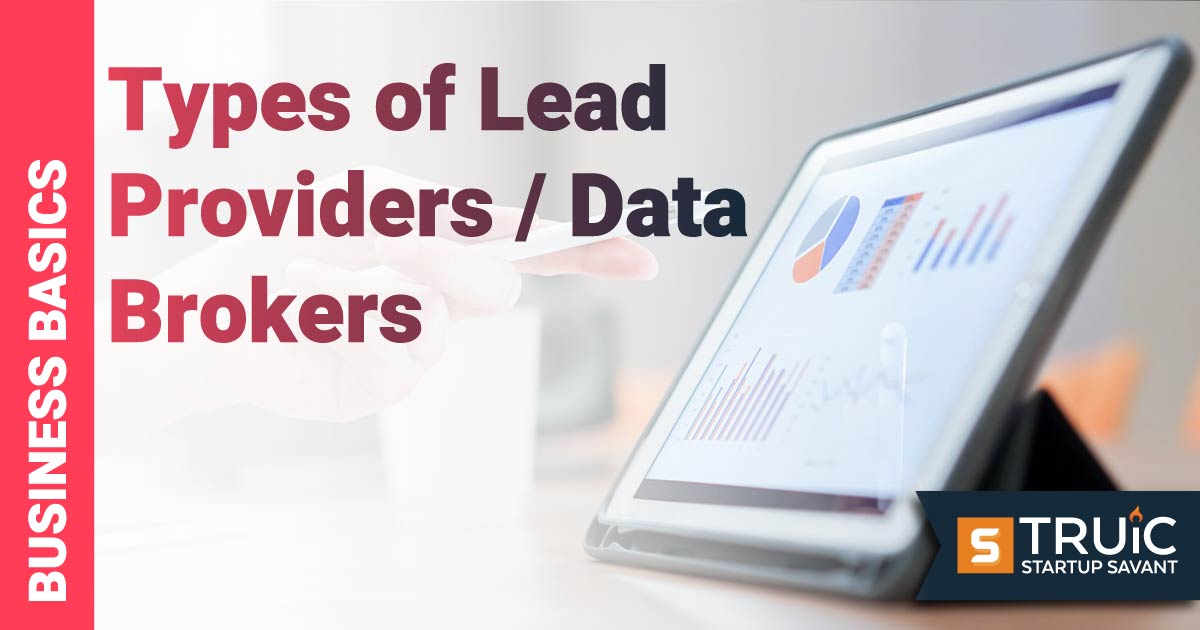What Are the Different Types of Lead Providers / Data Brokers?
A Guide to Finding the Right Leads for Your Company

Last Updated: By Mark Shalinsky
You’ve started your business-to-business (B2B) company, and you want to grow your startup by reaching out to prospective clients that may not already be aware of your products or services. As such, you need to find the right leads with the right information so you and your team can reach out in the right way. If you’ve followed our guidelines in the previous article on identifying the right leads, you are stepping up and are ready to dig in and start testing different types of lead providers.
The key value a lead provider brings is its ability to append and enhance the data. Typically, a reasonable marketer or sales representative can find a name. However, that is not entirely useful for their marketing or sales process; that lead needs to have data appended to it and sometimes that data needs to be enhanced.
Appended data is simply adding their title, phone number, email address, company details, and any other data that is usually available but sometimes not overtly available.
Enhancing the data usually requires some sort of manipulation. For example, if you have appended employee counts to the company data, binning those employee counts into groups would be an enhancement. Another example would be parsing their business title.
When you do an append and enhance routine on data, it is sometimes referred to as enrichment.
In this article, we will be talking solely about pulling B2B leads, not B2C leads. That being said, some of the tactics may be used to pull B2C leads.
Lead Providers 101
Data brokers can be split into two basic categories;
- Scraped lead data
- Data lakes
With these categories, lead data can be put through a number of verification methods, with the highest level being human-verified leads; an actual human makes a phone call, confirms that the individual on the other end is indeed the person listed on the lead record in the lead database, and the verification date is added to the record.
Scraped Lead Data
The easiest and most efficient way of getting lead data is to scrape the internet for information. In the old days, when I worked at JoVE.com, one summer, we hired twenty or so interns and had them visit and pull down all the publicly available contact information for faculty and post-docs at universities across the US. It was a costly and time-consuming activity; however, it provided a valuable resource for our sales team to reach out and promote our journal.
Today, doing the same process would cost far less and be accomplished far faster. How so? Automation and routines.
There are a number of low or no-code platforms, such as TexAu, Phantombuster, Octoparse, etc., that can help an organization scale and grow its lead databases. In short, these platforms will allow a non-technical user to point the technology at a website of interest and scrape the contact information required, drop it into a comma-separated file (CSV) that can be easily dropped into marketing automation, CRM, or sales enablement platform ready for outreach.
Implementations of Data Scrapers: LinkedIn
LinkedIn is a social network owned by Microsoft where many professionals have a profile and create posts regarding their business needs and requirements. For this reason, mining LinkedIn for prospect data is the main source of lead generation.
There are some issues scraping LinkedIn. First and foremost, unless you are directly connected to your prospect as a first-degree connection, you may not have access to their email. Even if you are a first-degree connection, their phone number is likely not available. Thus the only way to connect with that prospect is through the LinkedIn platform.
The second issue with LinkedIn is that you have a limited search of people who are not your first-degree connections. This is an intentional issue created specifically by LinkedIn as a monetization effort. Purchasing a paid LinkedIn Navigator account will remove this issue, allowing you to easily search for prospects far and wide within the LinkedIn social ecosystem. {affiliate link for LinkedIn navigator?}
Once you’ve found the leads that you are interested in, it is time to concurrently pull them out, append, and enhance their contact information with emails, phone numbers, etc.
The stepwise process may require several different platforms.
Currently, I use the LinkedIn navigator to run the search, extract the data using TexAu, then append and enhance the data using LeadIQ. While you can go from LinkedIn navigator directly to LeadIQ to append and enhance the data, I use several TexAu recipes in my prospecting.
Implementations of Data Scrapers: Local Businesses
If you are selling to local businesses, it is possible to run some data scraping automation routines to find those local businesses and then append and enhance the data.
For example, if you are selling a CRM specifically tailored to a chiropractic office, you might start by running a Google Maps search for chiropractic offices in your target market.
Next, you could use TexAu or Phantombuster to scrape the company data from Google Maps.
Once you have the company data, you can then either call them directly or enrich the data using a data scraper or data lake.
While these platforms are considered easy to use, the word “easy” when dealing with technology is relative and is very much user-dependent. Confounding the issue is that marketing and sales professionals have far better insights into what is a good lead pool versus a poor lead pool than a technology intern or operations person who may be using the software. In these cases, leads that don’t entirely fit the ideal customer profile (ICP) may be pulled, dropped into a marketing or sales cadence, and then resulting in the marketing efforts falling flat and the sales representative missing quota, respectively.
Lead Data Lakes
While lead scraping databases find publicly available data and scrape them, lead data lake providers employ people to actively hunt out, identify, and build lead databases. The key differentiating factor here is that with a lead scraping too, you are in most cases required to come with some information pertaining to your lead-in question, and the provider will match the lead characteristics with scraped data, scrape the lead anew, thus the lead data lake is its own searchable database.
The biggest players in this space are ZoomInfo, Slintel, Infotelligent, Apollo, etc. With each of these platforms, a user can log in and do a search based on both company and individual demographic data. The competition in this sector is heating up; thus, the lead data lake providers are offering more services and products to enhance the value of their lead sourcing service.
Intent Data
With all the world’s information available to us at our fingertips, prospects are continually searching for information on the services and or products that can solve their problems. If a sales or marketing representative can tap into what their prospective customers are looking for, that can easily solve their most desperate and time-consuming issue; finding the right lead at the right time. In other words, tapping into the buyer's intent.
Indirect Method
Historically there have been intent data providers such as TechTarget, Madison Logic, Ziff Davis, QuinStreet, Bombora, Aberdeen, and Harte Hanks. They provide their customers and subscribers with the names and demographic data of the companies where people therein are consuming content related to their services or products.
While this is all well and good, it is still up to the marketing or sales rep who’s consuming this valuable intent data to ferret out the specific individual at that company, typically using a data lake provider. For this reason, companies such as ZoomInfo, Infotelligent, and SalesIntel have collaborated with intent data providers so they can provide the end customer with the name and contact information of the specific individuals at the companies where they were consuming the information indicating the intent to purchase a specific service or product.
Direct Method
Another way the data lakes providers provide intent data is through a more direct method; website visitor tracking. Again this is a service that has historically been provided by other vendors such as 6sense, LeadMagic, or Leadfeeder. However, they would only obviate the companies visiting your website; it would be up to the marketing and sales teams to bird dog the specific individual, usually via a lead data lake.
As the lead data lakes already have the information on the business contacts, the circuit to identify the exact individuals is much shorter.
Marketing and Sales Automation
Once marketing and sales teams have lead information, the next step is to market and sell to them. This is typically done via email, phone calls, SMS/Text, and social media engagement. There are a slew of sales enablement platforms such as Outplay, Outreach, Salesloft, Yesware, Toutapp, Reply, etc., that perform these duties. The lead data is fed from the CRM to the sales enablement platform creating a multi-point and integrated sales stack.
First off, often less than 10% of prospects convert to bona fide sales qualified leads and second, with larger sales teams, leads may be exported multiple times only to be identified as duplicates when they are imported into the CRM. For these reasons, data lake providers such as Zoominfo, Apollo, and Slintel have opted to build their own marketing and sales automation cadence systems into their platforms. This way, as soon as a sales or marketing representative identifies a prospect, they can immediately enroll them into an automation sequence.
While decreasing the time to engage with prospects, this action also reduces the number of duplicates exported and reduces the size of the lead data in a marketing automation platform that may incur higher fees as Marketo, Eloqua, and HubSpot all have a surcharge on lead volume.
Conclusion
Growing a business is hard — one of the key reasons is that finding prospects to do outbound marketing and sales to is a non-trivial task. Depending on where your prospects hang out online will determine if a data lake or a data scraper is the best way to find your lead’s contact information. Larger, more established companies may subscribe to several sources.
The best way to determine which provider is best for your business and your needs is to contact several subscribers, sit through a demo, inquire how they curate lists of your ideal customer profiles (ICPs) and ask for a small sample of leads to test.
FAQ
What is lead generation?
Lead generation is the process of developing a list of potential prospects that would be interested in your product or service.
Why do I need a lead generation tool?
If you would like to find contact information for your prospects, you will likely need a lead generation tool. A lead generation tool will allow you to search for and find all the contact information for your prospects, such as email, phone number, cell number, social media profiles, etc.
What is the best lead generation tool?
The best lead generation tool is one that provides you and your team with the right contacts with the most relevant contact information. If you are sending business-to-business emails, a platform that can scrap and enhance information from LinkedIn will suffice. If you were looking for cellphone numbers, that type of data broker might not be the one for you.


